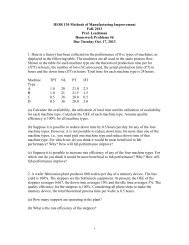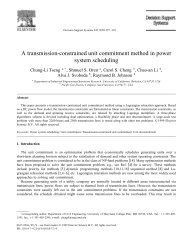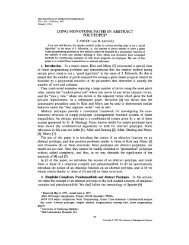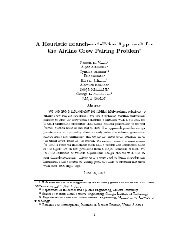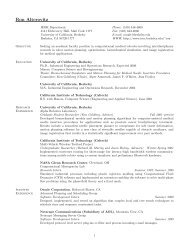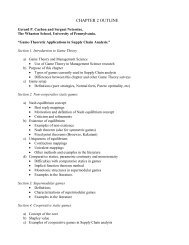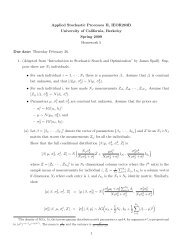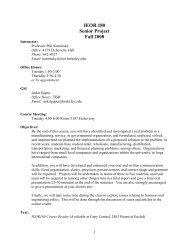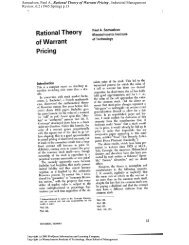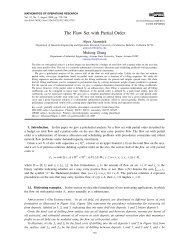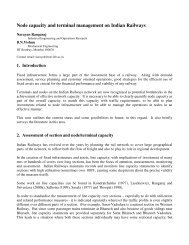- Page 1 and 2: IEOR 269, Spring 2010 Integer Progr
- Page 3 and 4: IEOR269 notes, Prof. Hochbaum, 2010
- Page 5 and 6: IEOR269 notes, Prof. Hochbaum, 2010
- Page 7 and 8: IEOR269 notes, Prof. Hochbaum, 2010
- Page 9 and 10: IEOR269 notes, Prof. Hochbaum, 2010
- Page 11 and 12: IEOR269 notes, Prof. Hochbaum, 2010
- Page 13 and 14: IEOR269 notes, Prof. Hochbaum, 2010
- Page 15 and 16: IEOR269 notes, Prof. Hochbaum, 2010
- Page 17: IEOR269 notes, Prof. Hochbaum, 2010
- Page 21 and 22: IEOR269 notes, Prof. Hochbaum, 2010
- Page 23 and 24: IEOR269 notes, Prof. Hochbaum, 2010
- Page 25 and 26: IEOR269 notes, Prof. Hochbaum, 2010
- Page 27 and 28: IEOR269 notes, Prof. Hochbaum, 2010
- Page 29 and 30: IEOR269 notes, Prof. Hochbaum, 2010
- Page 31 and 32: IEOR269 notes, Prof. Hochbaum, 2010
- Page 33 and 34: IEOR269 notes, Prof. Hochbaum, 2010
- Page 35 and 36: IEOR269 notes, Prof. Hochbaum, 2010
- Page 37 and 38: IEOR269 notes, Prof. Hochbaum, 2010
- Page 39 and 40: IEOR269 notes, Prof. Hochbaum, 2010
- Page 41 and 42: IEOR269 notes, Prof. Hochbaum, 2010
- Page 43 and 44: IEOR269 notes, Prof. Hochbaum, 2010
- Page 45 and 46: IEOR269 notes, Prof. Hochbaum, 2010
- Page 47 and 48: IEOR269 notes, Prof. Hochbaum, 2010
- Page 49 and 50: IEOR269 notes, Prof. Hochbaum, 2010
- Page 51 and 52: IEOR269 notes, Prof. Hochbaum, 2010
- Page 53 and 54: IEOR269 notes, Prof. Hochbaum, 2010
- Page 55 and 56: IEOR269 notes, Prof. Hochbaum, 2010
- Page 57 and 58: IEOR269 notes, Prof. Hochbaum, 2010
- Page 59 and 60: IEOR269 notes, Prof. Hochbaum, 2010
- Page 61 and 62: IEOR269 notes, Prof. Hochbaum, 2010
- Page 63 and 64: IEOR269 notes, Prof. Hochbaum, 2010
- Page 65 and 66: IEOR269 notes, Prof. Hochbaum, 2010
- Page 67 and 68: IEOR269 notes, Prof. Hochbaum, 2010
- Page 69 and 70:
IEOR269 notes, Prof. Hochbaum, 2010
- Page 71 and 72:
IEOR269 notes, Prof. Hochbaum, 2010
- Page 73 and 74:
IEOR269 notes, Prof. Hochbaum, 2010
- Page 75 and 76:
IEOR269 notes, Prof. Hochbaum, 2010
- Page 77 and 78:
IEOR269 notes, Prof. Hochbaum, 2010
- Page 79 and 80:
IEOR269 notes, Prof. Hochbaum, 2010
- Page 81 and 82:
IEOR269 notes, Prof. Hochbaum, 2010
- Page 83 and 84:
IEOR269 notes, Prof. Hochbaum, 2010
- Page 85 and 86:
IEOR269 notes, Prof. Hochbaum, 2010
- Page 87 and 88:
IEOR269 notes, Prof. Hochbaum, 2010
- Page 89 and 90:
IEOR269 notes, Prof. Hochbaum, 2010
- Page 91 and 92:
IEOR269 notes, Prof. Hochbaum, 2010
- Page 93 and 94:
IEOR269 notes, Prof. Hochbaum, 2010
- Page 95 and 96:
IEOR269 notes, Prof. Hochbaum, 2010
- Page 97 and 98:
IEOR269 notes, Prof. Hochbaum, 2010
- Page 99 and 100:
IEOR269 notes, Prof. Hochbaum, 2010
- Page 101 and 102:
References 1. G.B. Dantzig & D.R. F
- Page 103 and 104:
IEOR269 notes, Prof. Hochbaum, 2010
- Page 105 and 106:
IEOR269 notes, Prof. Hochbaum, 2010
- Page 107 and 108:
IEOR269 notes, Prof. Hochbaum, 2010
- Page 109 and 110:
IEOR269 notes, Prof. Hochbaum, 2010
- Page 111 and 112:
IEOR269 notes, Prof. Hochbaum, 2010
- Page 113 and 114:
IEOR269 notes, Prof. Hochbaum, 2010
- Page 115 and 116:
IEOR269 notes, Prof. Hochbaum, 2010
- Page 117 and 118:
IEOR269 notes, Prof. Hochbaum, 2010
- Page 119 and 120:
IEOR269 notes, Prof. Hochbaum, 2010
- Page 121 and 122:
IEOR269 notes, Prof. Hochbaum, 2010
- Page 123 and 124:
IEOR269 notes, Prof. Hochbaum, 2010
- Page 125 and 126:
IEOR269 notes, Prof. Hochbaum, 2010
- Page 127 and 128:
IEOR269 notes, Prof. Hochbaum, 2010
- Page 129 and 130:
IEOR269 notes, Prof. Hochbaum, 2010
- Page 131 and 132:
IEOR269 notes, Prof. Hochbaum, 2010
- Page 133 and 134:
IEOR269 notes, Prof. Hochbaum, 2010
- Page 135 and 136:
IEOR269 notes, Prof. Hochbaum, 2010
- Page 137 and 138:
IEOR269 notes, Prof. Hochbaum, 2010
- Page 139 and 140:
IEOR269 notes, Prof. Hochbaum, 2010
- Page 141 and 142:
IEOR269 notes, Prof. Hochbaum, 2010
- Page 143 and 144:
IEOR269 notes, Prof. Hochbaum, 2010
- Page 145 and 146:
IEOR269 notes, Prof. Hochbaum, 2010




